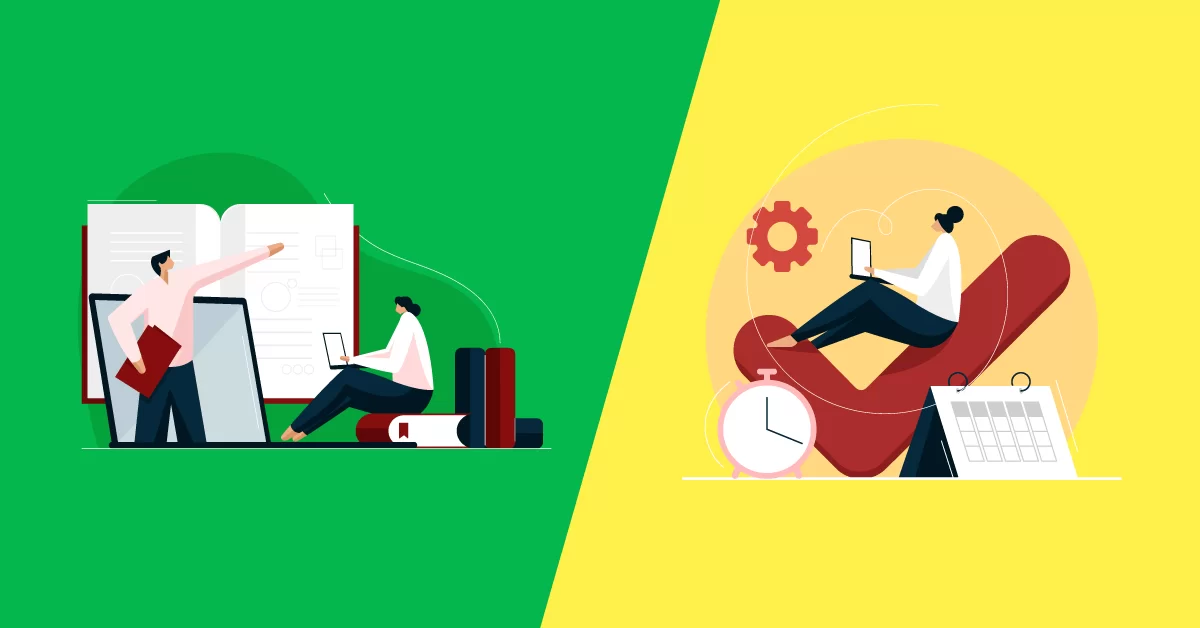
When we design courses, we inadvertently borrow many learning strategies from the K-12 classroom setting. Add to it the layers of andragogy (the science of teaching adults) and you have a well-rounded course.
Whether or not you are confident about including these learning strategies, go through this article. We will jog your memory and demonstrate how these scenarios play out and improve in the eLearning environment.
Workbook
Drill and practice activities are given in workbooks. Young learners are given structured material to help them master a concept. The level of the activities gets increasingly challenging, but remains within the scope of the subject.
The main purpose of the workbook is to practice through reinforcement exercises. You are doing this in a kinesthetic way; you fill in the blanks, draw, erase, cut and paste, place stickers, etc. It is fun and educational at the same time.
Consider these tips to transfer workbook exercises into the eLearning environment:
- Create an eLearning course mainly based on exercises. This could be highly interactive using the quiz feature of your LMS. Colourful drag and drop and rearranging exercises are attractive and stimulating to the learner.
- Build an easy-to-difficult practicing path based on competency and skills.
- Use interactive scenarios that are work-context based.
- Make it an enthralling experience in terms of visuals and sounds.
- You can never go wrong with the print option. Allow learners to print exercises and notes. We still love scribbling away with a pencil!
- Provide immediate feedback as a self-evaluation tool so that they can gauge their success.
Field Trip
We’ve all been to those eye-opening field trips we took back in the day to a museum or historical sites, castles and battlegrounds. How about those horticulture visits where we experienced rain forests and other biospheres? Aren’t they still vivid in our memories and most concepts related to them are still pretty recallable?
This is a classic multisensory learning experience that brings together social learning (learning with and from peers), storytelling (by a guide or a teacher), and by-the-way learning. Do you remember writing reflections regarding your findings, and using them for further learning activities? Such field trips break the mundane routine into a creative and energetic time for learning new material!
So how do we bring field trips in our eLearning environment?
- Develop a route for a virtual tour around the web for a project.
- Good examples in virtual field trips include: Customer service call center for placing an online order for pizza. Reflect on the online purchase experience.
- Request your eLearners to undergo an experience based on their course, for example talk to a product manager about the company’s latest product. Then ask them to comment and reflect on their observations based on structured criteria.
- Require your eLearners to share their reflections with peers and supervisors through the course.
Repetition
According to Hermann Ebbinghaus’ Forgetting Curve theory, all people have to repeat in order to remember things and routines. If we do not repeat newly learned formulas or definitions, we may forget it within 24 hours of learning. Repetitions are done through introducing similar scenarios with same problems requiring the use of newly learned solutions.
How do we integrate the repetition concept in our eLearning courses?
- Present booster quizzes between sections of your eLearning course after the section is completed and before a new section begins.
- Throughout the eLearning course, repeat the critical information: Tell stories, summarize, provide exercises and quizzes. Towards the end, administer a comprehensive test to ensure recall of the course objectives related information.
- Follow up with your eLearners through an email a month or so after they complete the course, with critical information from the course.
- As a rule of thumb, always provide multiple formats for assignment presentation and learning resources – let them print out cheatsheets, checklists, visuals, mindmaps, etc.
Note taking
Haven’t we all, at some point during our earlier school or high school education, taken notes?
Note taking is the most popular form of active or kinesthetic learning. We listen to lectures and presentations and want to scribble important data that will be deciphered later. This technique encourages us to rewrite the lecture by paraphrasing it, arranging it in our own structure, or connecting it with our own experiences.
Various forms of note taking such as stand alone texts, notes on a margin of the publication and highlighting text, reinforce memory. Pictograms and other visuals placed close to text also help us understand the material better.
So how can we stimulate note taking in our eLearning course?
- Enable the note taking option in your LMS.
- Provide freebie tools like mindmapping, pictogram making, visual note taking or speech input apps to your learners to encourage this technique in your eLearning courses.
- Summarize all sections towards their end and provide a print option for highlighting and other note taking activities for your learners.
- Create paragraphs of content and ask learners to fill in the missing areas.
- Ask eLearners to summarize important points and email it to their trainer, manager, or mentor.
Basic learning methods can easily be integrated in your next eLearning course using these ideas. Collaborate with the course mentor, the training manager and the learner to create more activities related to the basic learning methods.
Do tell us about your own experiences related to converting basic learning methods to eLearning activities.


